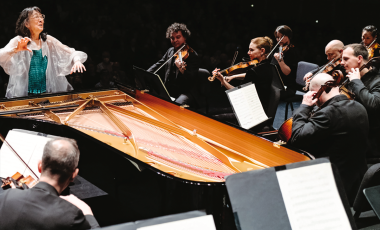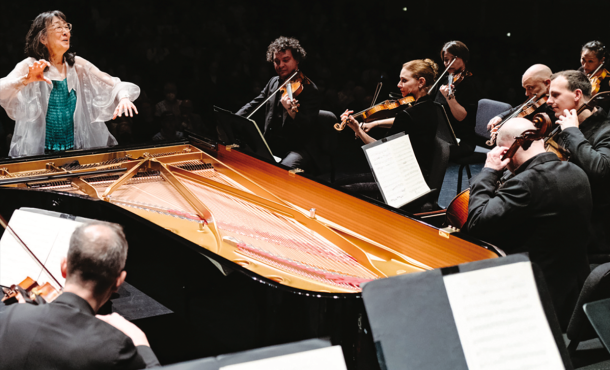 United States Mozart, Widmann: Mitsuko Uchida (piano / conductor), Mahler Chamber Orchestra. Cal Performances, Zellerbach Hall, University of California, Berkeley, 24.3.2024. (HS)
United States Mozart, Widmann: Mitsuko Uchida (piano / conductor), Mahler Chamber Orchestra. Cal Performances, Zellerbach Hall, University of California, Berkeley, 24.3.2024. (HS)

Mozart – Piano Concerto No.17 in G major; Piano Concerto No.22 in E-flat major
Widmann – ‘Chorale’ Quartet, adapted for flute, oboe, bassoon, celesta and string orchestra (U.S. premiere)
Mitsuko Uchida is renowned for her Mozart. Rapturous reviews for her performances of the concertos make an impressive compilation, and her understated approach can indeed play huge dividends in elegance and grace. Somehow, I had never been able to hear any of that live until this concert in Zellerbach Hall with the Mahler Chamber Orchestra.
The pianist and conductor, now 75, has been an Artistic Partner with the orchestra since 2016, including a series of tours and residencies in Europe, Asia and the Americas. It is the resident ensemble for the Lucerne Festival in Switzerland and Ojai Festival in California. Over the years Uchida and the MCO have explored most of the late Mozart concertos in concert and recording, and Sunday’s traversals of No.17 in G and No.22 in E-flat were marked by strong unanimity.
The orchestra was especially fluent. Uchida’s conducting established an ideal pace in paragraph after paragraph. She drew out subtle details that shaped phrasing with flexibility and a gentle pulse and, in orchestra-only sections of the music, her hands and arms communicated emphasis where needed and managed dynamics artfully. The orchestra’s sound had just enough weight to make its points without ever overstepping. When Uchida was busy at the piano, the orchestra clearly had the necessary history with her and an on-the-spot connection. They were on the same page in every detail.
Her playing, faithful to Mozart’s score, carefully executed every phrase. So why was something missing for me? She has talked in interviews about conjuring the sound of a fortepiano – the instrument for which Mozart wrote this music – on a modern concert grand, an instrument necessary for big auditoriums such as the 2000-seat Zellerbach Hall. To do so, she seems to minimize the ping and tone colors a modern piano can deliver, and my ears miss what that could do to convey the emotional content of Mozart’s music.
These choices put the emphasis on Mozart’s structure and narratives, especially in the Concerto in E-flat. The overture-like grand sweep at the top got things off to a vibrant start, her hands forming an ‘O’ to get a round sound in the trumpet punctuation. The flow of the orchestra’s exposition created expressive touchpoints as the themes played out, and when the piano finally entered, its flourishes weaving around those themes painted a picture that was accurate but with an almost analytical cast.
The glory was in the Andante that followed. It had a wistful feel, not quite sad, definitely never hinting at triumph, the piano’s interplay with the woodwinds finding beautiful moments.
The rondo finale, which relies on piano embroideries to lift the simple tunes into something more exciting, was taken at a tempo slightly slower than the Allegro that Mozart wrote. Uchida executed all the phrases with understated charm, getting a smile if not quite a grin in response, even when the piano goes off in an unexpected tangent just before the score’s end.
The Concerto in G major that began the program delivered the requisite contrasts in tone in the opening Allegro. The simplicity of the Andante was sublime, and the theme-and-variations finale benefited most from juicy playing by the entire orchestra. A little more color from Uchida would have brought out the wit in that movement. Again, though, her conducting was superb.
The Jörg Widmann piece, performed between the two Mozart concertos, made for a startling contrast. Widmann adapted his Second String Quartet, the ‘Chorale’, which debuted in 2003, for flute, oboe, bassoon, celesta and string orchestra. This was its U.S. premiere; the world premiere by the MCO was in 2020 in Pamplona, Spain.
Widmann was inspired by a Haydn string quartet, ‘The Seven Last Words of Jesus Christ’, where each word is set to a slow movement if its own. Although the quartet version of Haydn’s work is the best known of several variations, including an oratorio, it was originally a piece for orchestra, so Widmann’s timeline is sort of a reverse of Haydn’s – which also debuted in Spain (in his case Cadiz).
Unlike Mozart’s music of bonhomie and benevolence, the mood of Widmann’s work swings from one wrenching emotional peak to another. He is fascinated with sheer sound more than form, and the work is essentially a series of musical incidents that each begin quietly and veer into gritty dissonances and groans of sounds made with ‘extended’ techniques, before receding into silence.
The piece starts softly, almost apologetically breaking the silence with quiet unisons and gentle, consonant harmonies before edging to a gritty climax. These emotional peaks were achieved with the woodwinds and celesta arrayed in the first balcony to create an unusual sound mix with the strings on stage. It is quite an adventure, but without a noticeable form all these inventive and distinctive moments waft past without (at least at this first listening) cohering into a detectable narrative.
If the Widmann work had a programmatic connection with the Mozart concertos it was that it was inspired by a contemporary of Mozart’s, and made a thought-provoking contrast in both its musical language and intent. Perhaps Uchida seemed to downplay her piano part in Mozart to enhance that contrast.
In any event, it made for a musically rich afternoon.
Harvey Steiman
